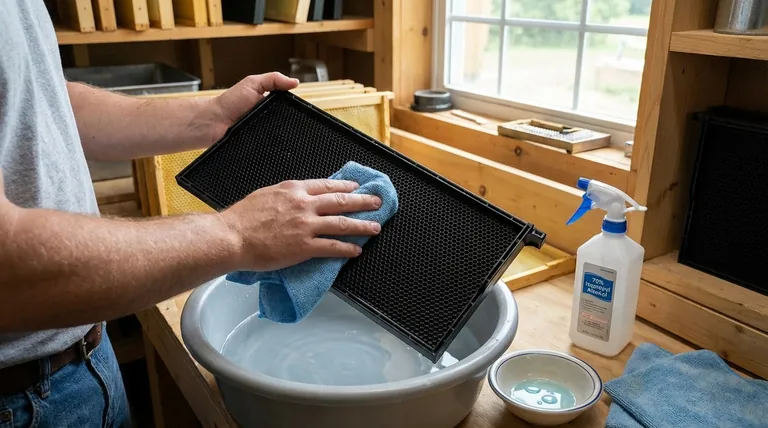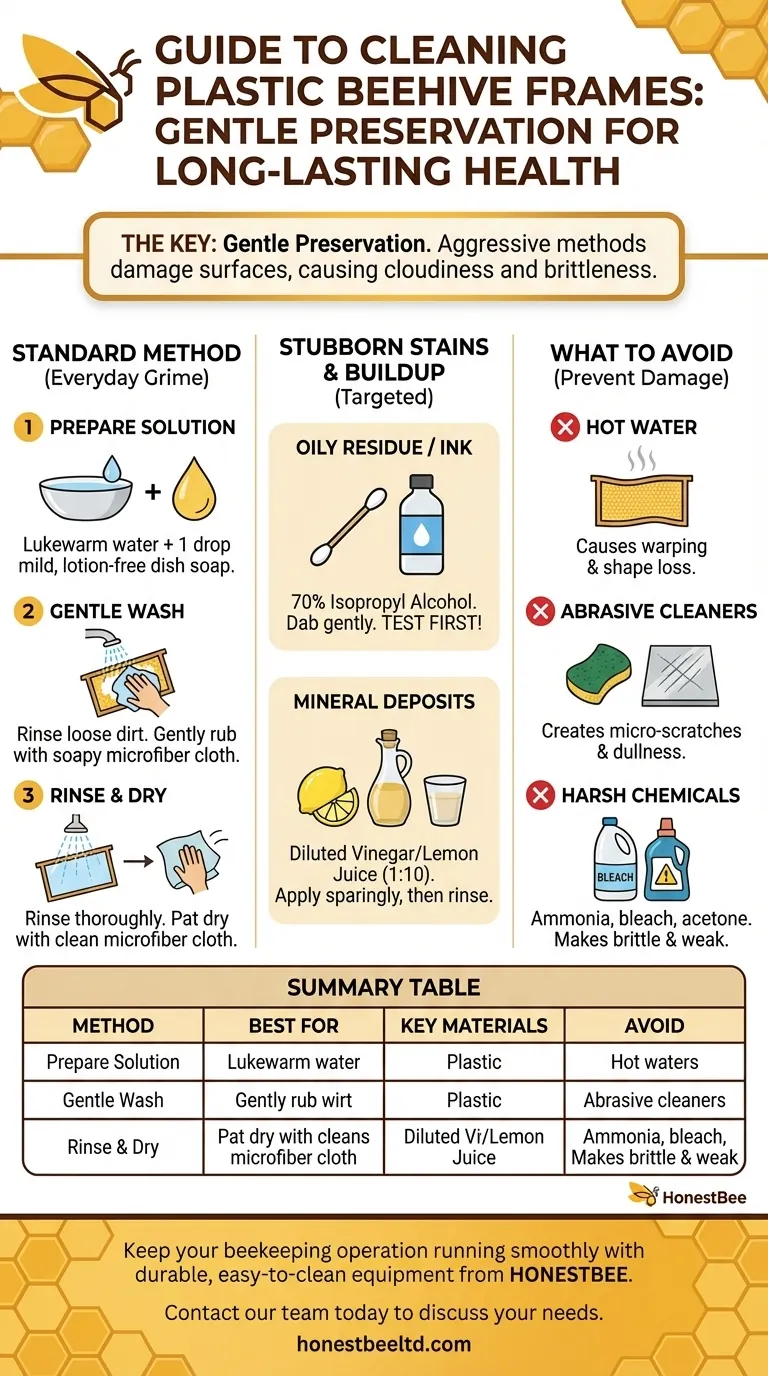To clean plastic frames safely, the most reliable method is to use lukewarm water, a drop of mild dish soap, and a soft microfiber cloth. Avoid using hot water, which can warp the plastic, or harsh chemical cleaners like ammonia or bleach, as they can degrade the material and ruin its finish. For delicate items like eyeglasses, this gentle approach is essential for preventing damage.
The key to cleaning plastic frames is gentle preservation. Aggressive methods and harsh chemicals might remove dirt, but they can also permanently damage the plastic's surface, causing cloudiness, brittleness, or discoloration.
The Standard Method for Everyday Grime
This simple, safe process is effective for most common cleaning needs, from eyeglass frames to picture frames.
Prepare Your Cleaning Solution
Start by creating a simple solution of lukewarm water in a small bowl or sink. Add a single drop of mild, lotion-free dish soap, and swish it around to create a light foam.
The Gentle Washing Process
First, rinse the frames under a gentle stream of lukewarm tap water to remove any loose dust or grit that could scratch the surface during cleaning. Then, dip your fingertips or a clean microfiber cloth into the soapy water and gently rub all surfaces of the plastic frame.
Rinsing and Drying Correctly
Rinse the frames thoroughly under lukewarm water until all soap residue is gone. Failing to rinse completely can leave a dull film. Finally, pat the frames dry with a clean, dry microfiber cloth. Avoid paper towels or other materials, which can leave lint behind or cause micro-scratches.
Handling Stubborn Stains and Buildup
If soap and water don't suffice, you can move to a slightly stronger, but still cautious, approach for targeted spots.
Using Isopropyl Alcohol (with Caution)
For oily residue, ink marks, or sticky buildup, a solution of 70% isopropyl alcohol can be effective. Lightly dampen a cotton swab or a corner of a microfiber cloth with the alcohol and gently dab the affected spot. Always test on an inconspicuous area first to ensure it doesn't harm the plastic's finish.
The Role of Mild Acids
A diluted solution of white vinegar or lemon juice can help break down mineral deposits from hard water. Mix one part vinegar or juice with ten parts water. Apply it sparingly with a cloth, then rinse the frame thoroughly with plain water and dry it completely.
Understanding the Trade-offs and What to Avoid
Knowing what not to do is as important as knowing what to do. The goal is to clean the frames without causing irreversible damage.
The Danger of Hot Water
Exposing plastic frames to hot water can cause them to soften and lose their shape. This is particularly critical for precisely fitted items like eyeglasses, where even minor warping can ruin their alignment.
Abrasive Cleaners and Materials
Never use scouring pads, steel wool, or abrasive cleaning powders. These will create a network of micro-scratches on the plastic's surface, giving it a permanently dull and cloudy appearance.
Harsh Chemical Solvents
Avoid common household cleaners containing ammonia, bleach, or acetone (nail polish remover). These powerful solvents can break down the chemical structure of the plastic, making it brittle, discolored, and weak.
Making the Right Choice for Your Frames
Choose your cleaning method based on the type of dirt you need to remove.
- If your primary focus is routine maintenance (dust and fingerprints): A dry or slightly damp microfiber cloth is sufficient and the safest option.
- If you're dealing with oils, smudges, or light grime: Use the standard method of lukewarm water with a single drop of mild dish soap.
- If you face stubborn stains or sticky residue: Spot-treat carefully with a diluted solution of isopropyl alcohol, always testing a hidden area first and rinsing afterward.
By using the correct gentle methods, you can keep your plastic frames clean while preserving their integrity and appearance for years to come.

Summary Table:
| Cleaning Method | Best For | Key Materials | What to Avoid |
|---|---|---|---|
| Standard Wash | Everyday dust, fingerprints, light grime | Lukewarm water, mild dish soap, microfiber cloth | Hot water, abrasive materials |
| Stubborn Stains | Oily residue, ink, sticky buildup | 70% isopropyl alcohol (test first), cotton swab | Bleach, ammonia, acetone |
| Mineral Deposits | Hard water spots | Diluted white vinegar/lemon juice solution | Harsh chemical cleaners |
Keep your beekeeping operation running smoothly with durable, easy-to-clean equipment from HONESTBEE.
As a trusted supplier for commercial apiaries and distributors, we understand that clean, well-maintained plastic frames are essential for hive health and productivity. Our wholesale-focused operations provide the high-quality supplies you need to succeed.
Contact our team today to discuss your beekeeping equipment needs and discover the HONESTBEE difference!
Visual Guide

Related Products
- Plastic Bee Frame Beekeeping Hive Frames for Wholesale
- 7 x Auto Bee Flow Hive Frames Plastic Beekeeping Hive Box Supplies
- Assembled Wooden Bee Frames with Plastic Foundation for Durability and Convenience by HONESTBEE
- Plastic Honey Comb Frames Cassette Box for Honey
- Professional In-Hive Bee Feeder HONESTBEE Frame for Beekeeping
People Also Ask
- Can you boil plastic bee frames? Avoid This Costly Mistake and Protect Your Hive
- What is the role of oxalic acid in plants? A Key to Plant Defense and Internal Regulation
- What are the main types of frames available for beehives? Wood vs. Plastic for Your Apiary
- Are plastic frames good? Boost Apiary Efficiency with Durable, Pest-Resistant Frames
- What are the advantages of plastic frames for beehives? Boost Apiary Efficiency & Durability



















